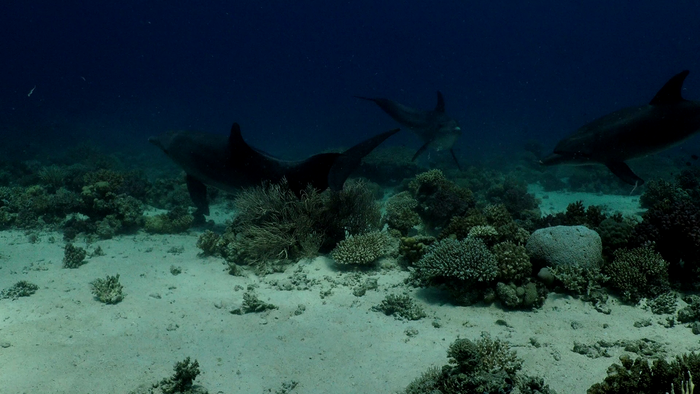If a human comes down with a rash, they might go to the doctor and come away with some ointment to put on it. Indo-Pacific bottlenose dolphins get skin conditions, too, but they come about their medication by queuing up nose-to-tail to rub themselves against corals. In the journal iScience on May 19, researchers show that these corals have medicinal properties, suggesting that the dolphins are using the marine invertebrates to medicate skin conditions.

Credit: Angela Ziltener
If a human comes down with a rash, they might go to the doctor and come away with some ointment to put on it. Indo-Pacific bottlenose dolphins get skin conditions, too, but they come about their medication by queuing up nose-to-tail to rub themselves against corals. In the journal iScience on May 19, researchers show that these corals have medicinal properties, suggesting that the dolphins are using the marine invertebrates to medicate skin conditions.
Thirteen years ago, co-lead author Angela Ziltener (@DWAORG), a wildlife biologist at the University of Zurich, Switzerland, first observed dolphins rubbing against coral in the Northern Red Sea, off the coast of Egypt. She and her team noticed that the dolphins were selective about which corals they rubbed against, and they wanted to understand why. “I hadn’t seen this coral rubbing behavior described before, and it was clear that the dolphins knew exactly which coral they wanted to use,” says Ziltener. “I thought, ‘There must be a reason.’”
Most dolphin research is conducted from the surface of the water, but because Ziltener is a diver, she was able to study the dolphins up close. It took some time to earn the trust of the pod, which she was able to do in part because these dolphins weren’t phased by the large bubbles released by the diving tanks and habituated towards divers. “Some dolphins, like spinner dolphins in the Southern Egyptian Red Sea, are shyer regarding bubbles,” she says.
Once the pod allowed her to visit them regularly, she and her colleagues were able to identify and sample the corals that the dolphins were rubbing on. Ziltener and her team found that by repeatedly rubbing against the corals, Indo-Pacific bottlenose dolphins were agitating the tiny polyps that make up the coral community, and these invertebrates were releasing mucus. In order to understand what properties the mucus contained, the team collected samples of the coral.
When lead author Gertrud Morlock, an analytical chemist and food scientist at Justus Liebig University Giessen in Germany, and her team used planar separations combined with on-surface assays and high-resolution mass spectrometry to analyze samples of the gorgonian coral Rumphella aggregata, the leather coral Sarcophyton sp., and the sponge Ircinia sp., they found 17 active metabolites with antibacterial, antioxidative, hormonal, and toxic activities.
This discovery of these bioactive compounds led the team to believe that the mucus of the corals and sponges is serving to regulate the dolphin skin’s microbiome and treat infections. “Repeated rubbing allows the active metabolites to come into contact with the skin of the dolphins,” says Morlock. “These metabolites could help them achieve skin homeostasis and be useful for prophylaxis or auxiliary treatment against microbial infections.”
The reefs where these corals are found are important places for the local dolphin populations. They head there to rest and to have fun. “Many people don’t realize that these coral reefs are bedrooms for the dolphins, and playgrounds as well,” says Ziltener. In between naps, the dolphins often wake to perform the coral rubbing behavior. “It’s almost like they are showering, cleaning themselves before they go to sleep or get up for the day,” she says.
Since she began researching dolphins in Egypt in 2009, Ziltener has noticed a disturbing trend. “The tourism industry makes a lot of money now out of dolphin swimming. People are dreaming of swimming with the dolphins, so they are figuring out which reefs they use and disturbing the dolphins if they don’t follow the guidelines for how to approach them in a responsible way,” she says. She is so concerned that she has started an organization called Dolphin Watch Alliance, a conservation group that educates tour guides, tourists, and the public on how to give tourists experiences that are safe for dolphins, and has lobbied for the reefs to become protected areas.
Ziltener and her team hope that as long as the reefs remain a safe place for the dolphins, they can continue to study coral rubbing and identify which selected corals and sponges are being used for specific body parts.
###
This research was supported by the Egyptian Ministry of Environment, the rangers of the Red Sea National Parks Authority, the Sawiris Foundation, the German Research Foundation, the TU Berlin, Campus El Gouna, the Dolphin Watch Alliance, the Orca Dive Club El Gouna as well as to Aqualung, Germany, and Merck, Darmstadt, Germany.
iScience, Morlock and Ziltener et al.: “Evidence that Indo-Pacific bottlenose dolphins self-medicate with invertebrates in coral reefs.” https://www.cell.com/iscience/fulltext/S2589-0042(22)00541-7
iScience (@iScience_CP) is an open access journal from Cell Press that provides a platform for original research and interdisciplinary thinking in the life, physical, and earth sciences. The primary criterion for publication in iScience is a significant contribution to a relevant field combined with robust results and underlying methodology. Visit: http://www.cell.com/iscience. To receive Cell Press media alerts, contact [email protected].
Journal
iScience
DOI
10.1016/j.isci.2022.104271
Method of Research
Experimental study
Subject of Research
Animals
Article Title
Evidence that Indo-Pacific bottlenose dolphins self-medicate with invertebrates in coral reefs
Article Publication Date
19-May-2022




